Analysis of Management and Business Contextual Factors Report
VerifiedAdded on 2023/01/16
|7
|2057
|64
Report
AI Summary
This report provides an analysis of contextual factors and their influence on organizational decision-making. It begins with an introduction emphasizing the importance of contextual factors such as history, connectedness, and regulations, and how they impact information flows and interactions within organizations. The report then examines several journal articles that explore specific contextual factors. The first article focuses on corporate governance and its impact on firm strategy and compensation mechanisms, especially in the context of privatization. The second article investigates environmental forces and their influence on environmental disclosure by companies. The third article explores the role of risks confronting the firm and how dynamic capabilities contribute to organizational change. Another article highlights the importance of organization and best practices, especially in the business-to-business marketing context. The final article examines the influence of board demographic diversity on firm performance within Indian knowledge-intensive firms. The report concludes by summarizing the key findings and their relevance to organizational performance and decision-making, particularly for institutions like CQ University.
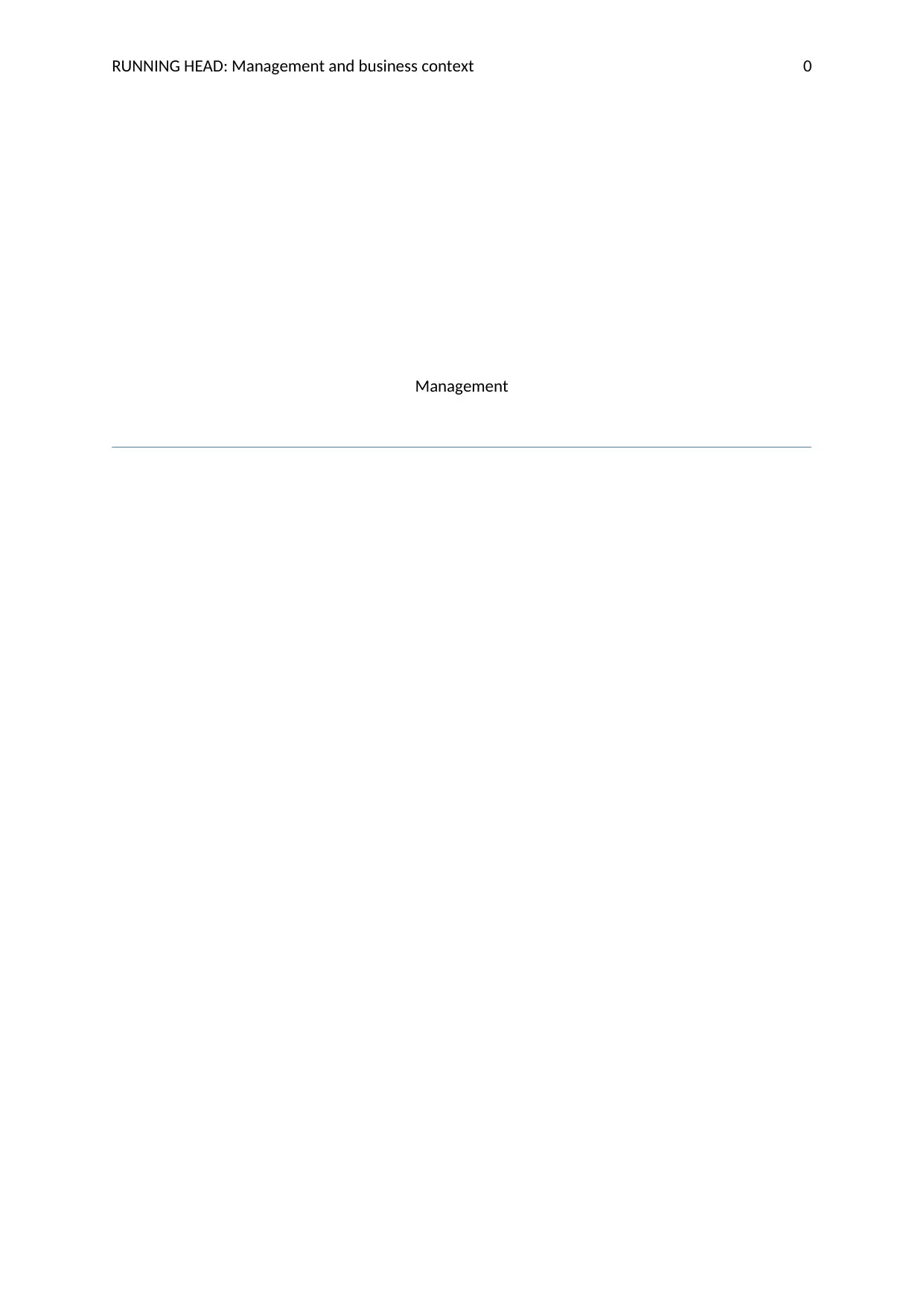
RUNNING HEAD: Management and business context 0
Management
Management
Paraphrase This Document
Need a fresh take? Get an instant paraphrase of this document with our AI Paraphraser
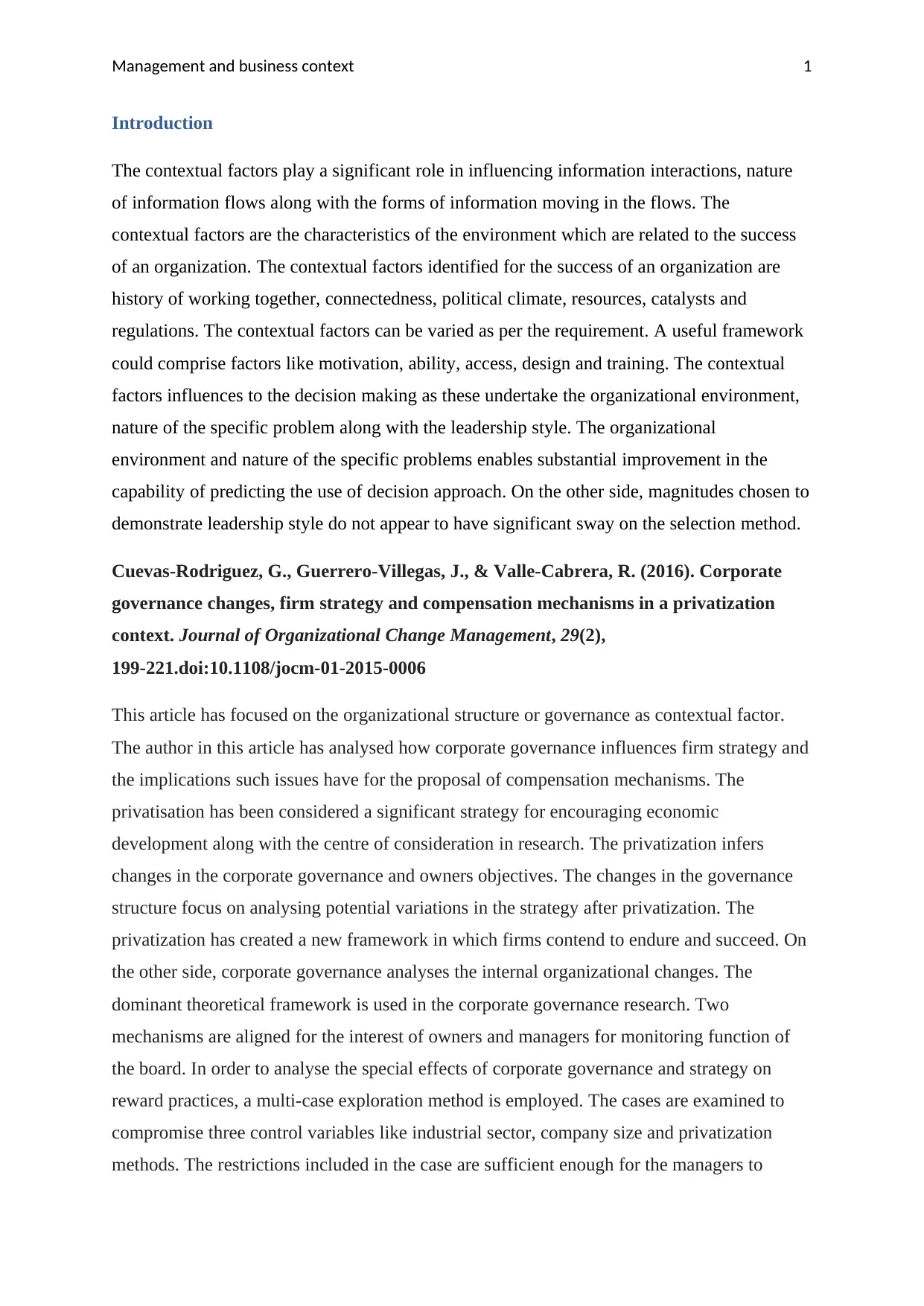
Management and business context 1
Introduction
The contextual factors play a significant role in influencing information interactions, nature
of information flows along with the forms of information moving in the flows. The
contextual factors are the characteristics of the environment which are related to the success
of an organization. The contextual factors identified for the success of an organization are
history of working together, connectedness, political climate, resources, catalysts and
regulations. The contextual factors can be varied as per the requirement. A useful framework
could comprise factors like motivation, ability, access, design and training. The contextual
factors influences to the decision making as these undertake the organizational environment,
nature of the specific problem along with the leadership style. The organizational
environment and nature of the specific problems enables substantial improvement in the
capability of predicting the use of decision approach. On the other side, magnitudes chosen to
demonstrate leadership style do not appear to have significant sway on the selection method.
Cuevas-Rodriguez, G., Guerrero-Villegas, J., & Valle-Cabrera, R. (2016). Corporate
governance changes, firm strategy and compensation mechanisms in a privatization
context. Journal of Organizational Change Management, 29(2),
199-221.doi:10.1108/jocm-01-2015-0006
This article has focused on the organizational structure or governance as contextual factor.
The author in this article has analysed how corporate governance influences firm strategy and
the implications such issues have for the proposal of compensation mechanisms. The
privatisation has been considered a significant strategy for encouraging economic
development along with the centre of consideration in research. The privatization infers
changes in the corporate governance and owners objectives. The changes in the governance
structure focus on analysing potential variations in the strategy after privatization. The
privatization has created a new framework in which firms contend to endure and succeed. On
the other side, corporate governance analyses the internal organizational changes. The
dominant theoretical framework is used in the corporate governance research. Two
mechanisms are aligned for the interest of owners and managers for monitoring function of
the board. In order to analyse the special effects of corporate governance and strategy on
reward practices, a multi-case exploration method is employed. The cases are examined to
compromise three control variables like industrial sector, company size and privatization
methods. The restrictions included in the case are sufficient enough for the managers to
Introduction
The contextual factors play a significant role in influencing information interactions, nature
of information flows along with the forms of information moving in the flows. The
contextual factors are the characteristics of the environment which are related to the success
of an organization. The contextual factors identified for the success of an organization are
history of working together, connectedness, political climate, resources, catalysts and
regulations. The contextual factors can be varied as per the requirement. A useful framework
could comprise factors like motivation, ability, access, design and training. The contextual
factors influences to the decision making as these undertake the organizational environment,
nature of the specific problem along with the leadership style. The organizational
environment and nature of the specific problems enables substantial improvement in the
capability of predicting the use of decision approach. On the other side, magnitudes chosen to
demonstrate leadership style do not appear to have significant sway on the selection method.
Cuevas-Rodriguez, G., Guerrero-Villegas, J., & Valle-Cabrera, R. (2016). Corporate
governance changes, firm strategy and compensation mechanisms in a privatization
context. Journal of Organizational Change Management, 29(2),
199-221.doi:10.1108/jocm-01-2015-0006
This article has focused on the organizational structure or governance as contextual factor.
The author in this article has analysed how corporate governance influences firm strategy and
the implications such issues have for the proposal of compensation mechanisms. The
privatisation has been considered a significant strategy for encouraging economic
development along with the centre of consideration in research. The privatization infers
changes in the corporate governance and owners objectives. The changes in the governance
structure focus on analysing potential variations in the strategy after privatization. The
privatization has created a new framework in which firms contend to endure and succeed. On
the other side, corporate governance analyses the internal organizational changes. The
dominant theoretical framework is used in the corporate governance research. Two
mechanisms are aligned for the interest of owners and managers for monitoring function of
the board. In order to analyse the special effects of corporate governance and strategy on
reward practices, a multi-case exploration method is employed. The cases are examined to
compromise three control variables like industrial sector, company size and privatization
methods. The restrictions included in the case are sufficient enough for the managers to
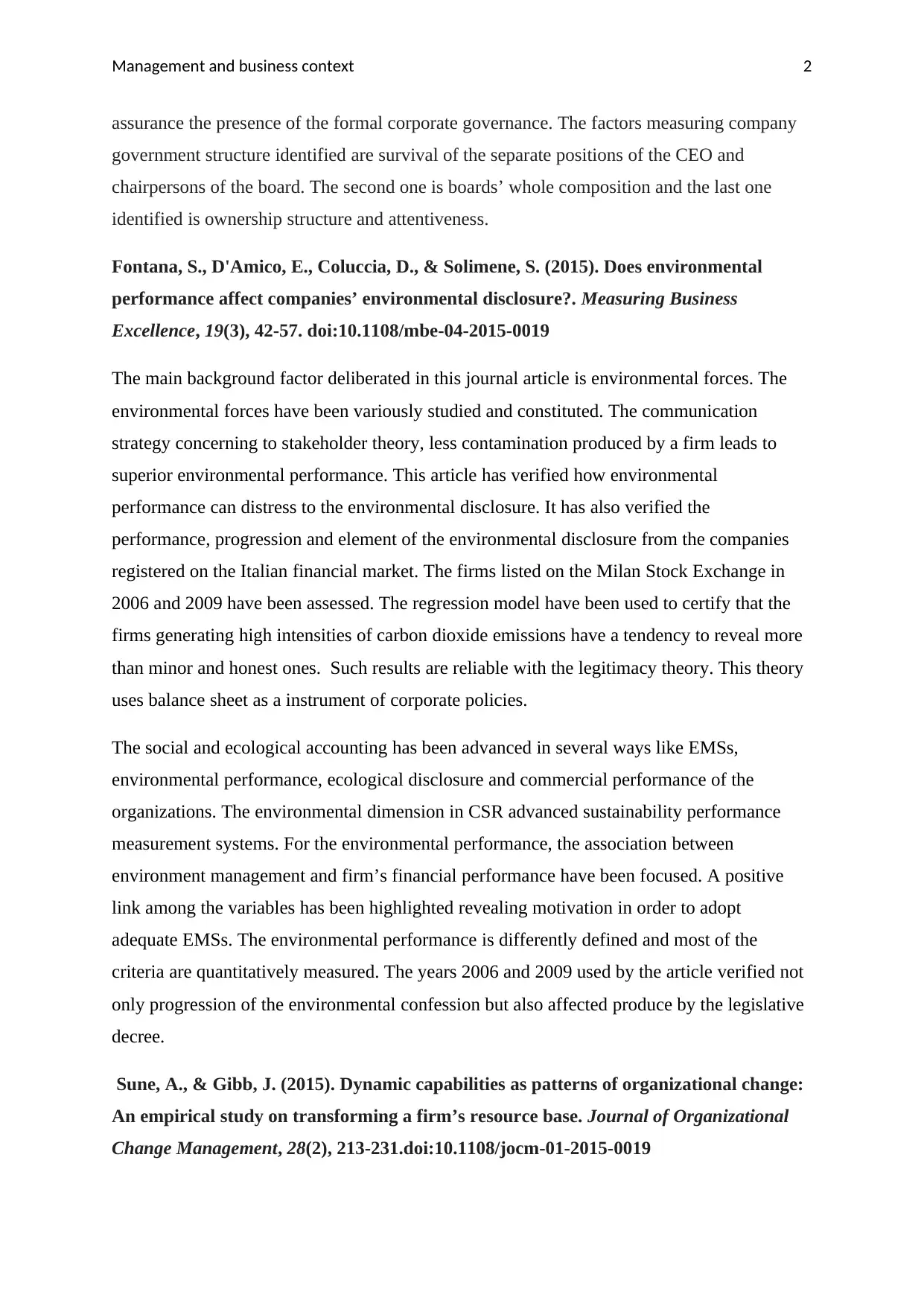
Management and business context 2
assurance the presence of the formal corporate governance. The factors measuring company
government structure identified are survival of the separate positions of the CEO and
chairpersons of the board. The second one is boards’ whole composition and the last one
identified is ownership structure and attentiveness.
Fontana, S., D'Amico, E., Coluccia, D., & Solimene, S. (2015). Does environmental
performance affect companies’ environmental disclosure?. Measuring Business
Excellence, 19(3), 42-57. doi:10.1108/mbe-04-2015-0019
The main background factor deliberated in this journal article is environmental forces. The
environmental forces have been variously studied and constituted. The communication
strategy concerning to stakeholder theory, less contamination produced by a firm leads to
superior environmental performance. This article has verified how environmental
performance can distress to the environmental disclosure. It has also verified the
performance, progression and element of the environmental disclosure from the companies
registered on the Italian financial market. The firms listed on the Milan Stock Exchange in
2006 and 2009 have been assessed. The regression model have been used to certify that the
firms generating high intensities of carbon dioxide emissions have a tendency to reveal more
than minor and honest ones. Such results are reliable with the legitimacy theory. This theory
uses balance sheet as a instrument of corporate policies.
The social and ecological accounting has been advanced in several ways like EMSs,
environmental performance, ecological disclosure and commercial performance of the
organizations. The environmental dimension in CSR advanced sustainability performance
measurement systems. For the environmental performance, the association between
environment management and firm’s financial performance have been focused. A positive
link among the variables has been highlighted revealing motivation in order to adopt
adequate EMSs. The environmental performance is differently defined and most of the
criteria are quantitatively measured. The years 2006 and 2009 used by the article verified not
only progression of the environmental confession but also affected produce by the legislative
decree.
Sune, A., & Gibb, J. (2015). Dynamic capabilities as patterns of organizational change:
An empirical study on transforming a firm’s resource base. Journal of Organizational
Change Management, 28(2), 213-231.doi:10.1108/jocm-01-2015-0019
assurance the presence of the formal corporate governance. The factors measuring company
government structure identified are survival of the separate positions of the CEO and
chairpersons of the board. The second one is boards’ whole composition and the last one
identified is ownership structure and attentiveness.
Fontana, S., D'Amico, E., Coluccia, D., & Solimene, S. (2015). Does environmental
performance affect companies’ environmental disclosure?. Measuring Business
Excellence, 19(3), 42-57. doi:10.1108/mbe-04-2015-0019
The main background factor deliberated in this journal article is environmental forces. The
environmental forces have been variously studied and constituted. The communication
strategy concerning to stakeholder theory, less contamination produced by a firm leads to
superior environmental performance. This article has verified how environmental
performance can distress to the environmental disclosure. It has also verified the
performance, progression and element of the environmental disclosure from the companies
registered on the Italian financial market. The firms listed on the Milan Stock Exchange in
2006 and 2009 have been assessed. The regression model have been used to certify that the
firms generating high intensities of carbon dioxide emissions have a tendency to reveal more
than minor and honest ones. Such results are reliable with the legitimacy theory. This theory
uses balance sheet as a instrument of corporate policies.
The social and ecological accounting has been advanced in several ways like EMSs,
environmental performance, ecological disclosure and commercial performance of the
organizations. The environmental dimension in CSR advanced sustainability performance
measurement systems. For the environmental performance, the association between
environment management and firm’s financial performance have been focused. A positive
link among the variables has been highlighted revealing motivation in order to adopt
adequate EMSs. The environmental performance is differently defined and most of the
criteria are quantitatively measured. The years 2006 and 2009 used by the article verified not
only progression of the environmental confession but also affected produce by the legislative
decree.
Sune, A., & Gibb, J. (2015). Dynamic capabilities as patterns of organizational change:
An empirical study on transforming a firm’s resource base. Journal of Organizational
Change Management, 28(2), 213-231.doi:10.1108/jocm-01-2015-0019
⊘ This is a preview!⊘
Do you want full access?
Subscribe today to unlock all pages.

Trusted by 1+ million students worldwide
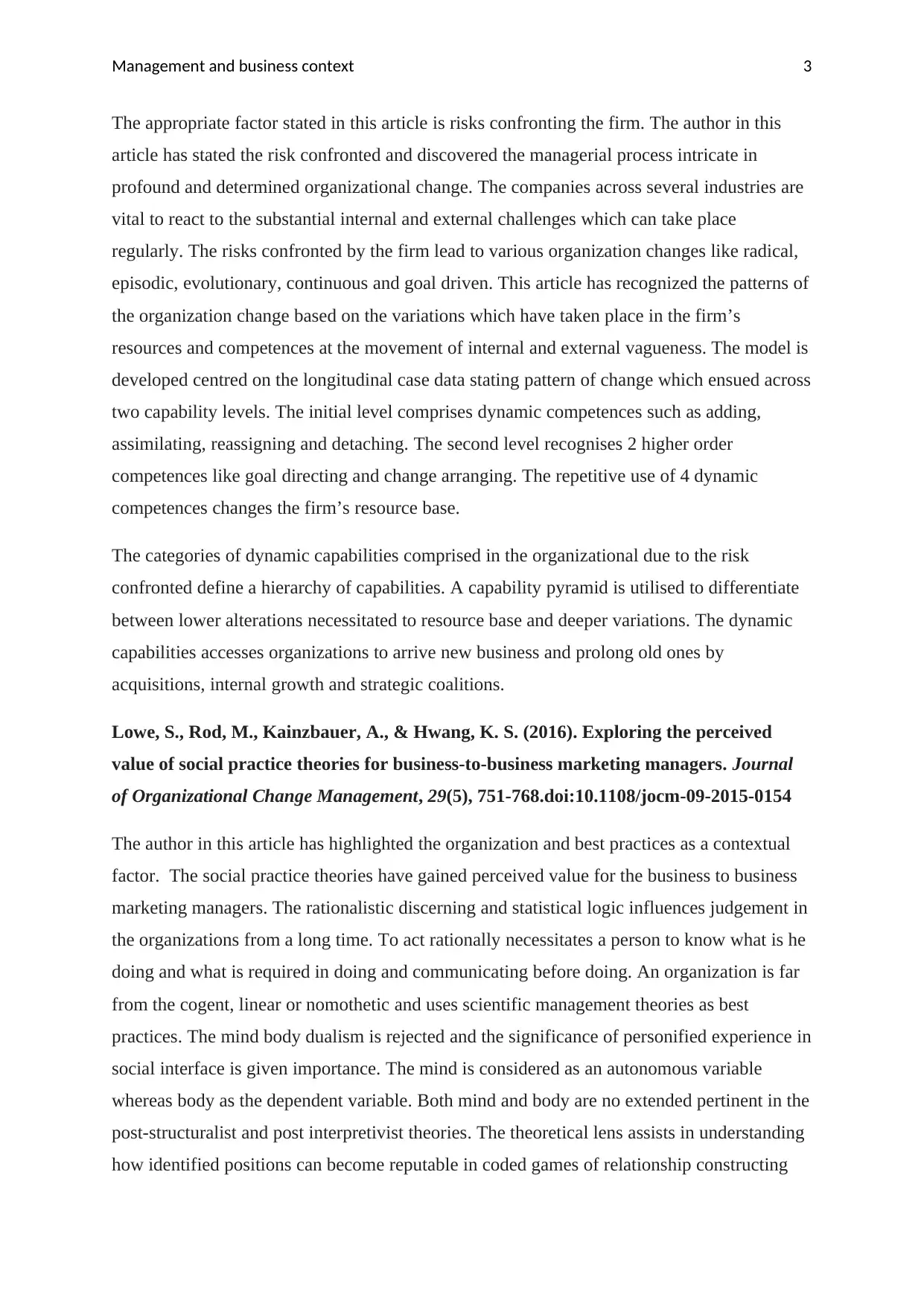
Management and business context 3
The appropriate factor stated in this article is risks confronting the firm. The author in this
article has stated the risk confronted and discovered the managerial process intricate in
profound and determined organizational change. The companies across several industries are
vital to react to the substantial internal and external challenges which can take place
regularly. The risks confronted by the firm lead to various organization changes like radical,
episodic, evolutionary, continuous and goal driven. This article has recognized the patterns of
the organization change based on the variations which have taken place in the firm’s
resources and competences at the movement of internal and external vagueness. The model is
developed centred on the longitudinal case data stating pattern of change which ensued across
two capability levels. The initial level comprises dynamic competences such as adding,
assimilating, reassigning and detaching. The second level recognises 2 higher order
competences like goal directing and change arranging. The repetitive use of 4 dynamic
competences changes the firm’s resource base.
The categories of dynamic capabilities comprised in the organizational due to the risk
confronted define a hierarchy of capabilities. A capability pyramid is utilised to differentiate
between lower alterations necessitated to resource base and deeper variations. The dynamic
capabilities accesses organizations to arrive new business and prolong old ones by
acquisitions, internal growth and strategic coalitions.
Lowe, S., Rod, M., Kainzbauer, A., & Hwang, K. S. (2016). Exploring the perceived
value of social practice theories for business-to-business marketing managers. Journal
of Organizational Change Management, 29(5), 751-768.doi:10.1108/jocm-09-2015-0154
The author in this article has highlighted the organization and best practices as a contextual
factor. The social practice theories have gained perceived value for the business to business
marketing managers. The rationalistic discerning and statistical logic influences judgement in
the organizations from a long time. To act rationally necessitates a person to know what is he
doing and what is required in doing and communicating before doing. An organization is far
from the cogent, linear or nomothetic and uses scientific management theories as best
practices. The mind body dualism is rejected and the significance of personified experience in
social interface is given importance. The mind is considered as an autonomous variable
whereas body as the dependent variable. Both mind and body are no extended pertinent in the
post-structuralist and post interpretivist theories. The theoretical lens assists in understanding
how identified positions can become reputable in coded games of relationship constructing
The appropriate factor stated in this article is risks confronting the firm. The author in this
article has stated the risk confronted and discovered the managerial process intricate in
profound and determined organizational change. The companies across several industries are
vital to react to the substantial internal and external challenges which can take place
regularly. The risks confronted by the firm lead to various organization changes like radical,
episodic, evolutionary, continuous and goal driven. This article has recognized the patterns of
the organization change based on the variations which have taken place in the firm’s
resources and competences at the movement of internal and external vagueness. The model is
developed centred on the longitudinal case data stating pattern of change which ensued across
two capability levels. The initial level comprises dynamic competences such as adding,
assimilating, reassigning and detaching. The second level recognises 2 higher order
competences like goal directing and change arranging. The repetitive use of 4 dynamic
competences changes the firm’s resource base.
The categories of dynamic capabilities comprised in the organizational due to the risk
confronted define a hierarchy of capabilities. A capability pyramid is utilised to differentiate
between lower alterations necessitated to resource base and deeper variations. The dynamic
capabilities accesses organizations to arrive new business and prolong old ones by
acquisitions, internal growth and strategic coalitions.
Lowe, S., Rod, M., Kainzbauer, A., & Hwang, K. S. (2016). Exploring the perceived
value of social practice theories for business-to-business marketing managers. Journal
of Organizational Change Management, 29(5), 751-768.doi:10.1108/jocm-09-2015-0154
The author in this article has highlighted the organization and best practices as a contextual
factor. The social practice theories have gained perceived value for the business to business
marketing managers. The rationalistic discerning and statistical logic influences judgement in
the organizations from a long time. To act rationally necessitates a person to know what is he
doing and what is required in doing and communicating before doing. An organization is far
from the cogent, linear or nomothetic and uses scientific management theories as best
practices. The mind body dualism is rejected and the significance of personified experience in
social interface is given importance. The mind is considered as an autonomous variable
whereas body as the dependent variable. Both mind and body are no extended pertinent in the
post-structuralist and post interpretivist theories. The theoretical lens assists in understanding
how identified positions can become reputable in coded games of relationship constructing
Paraphrase This Document
Need a fresh take? Get an instant paraphrase of this document with our AI Paraphraser
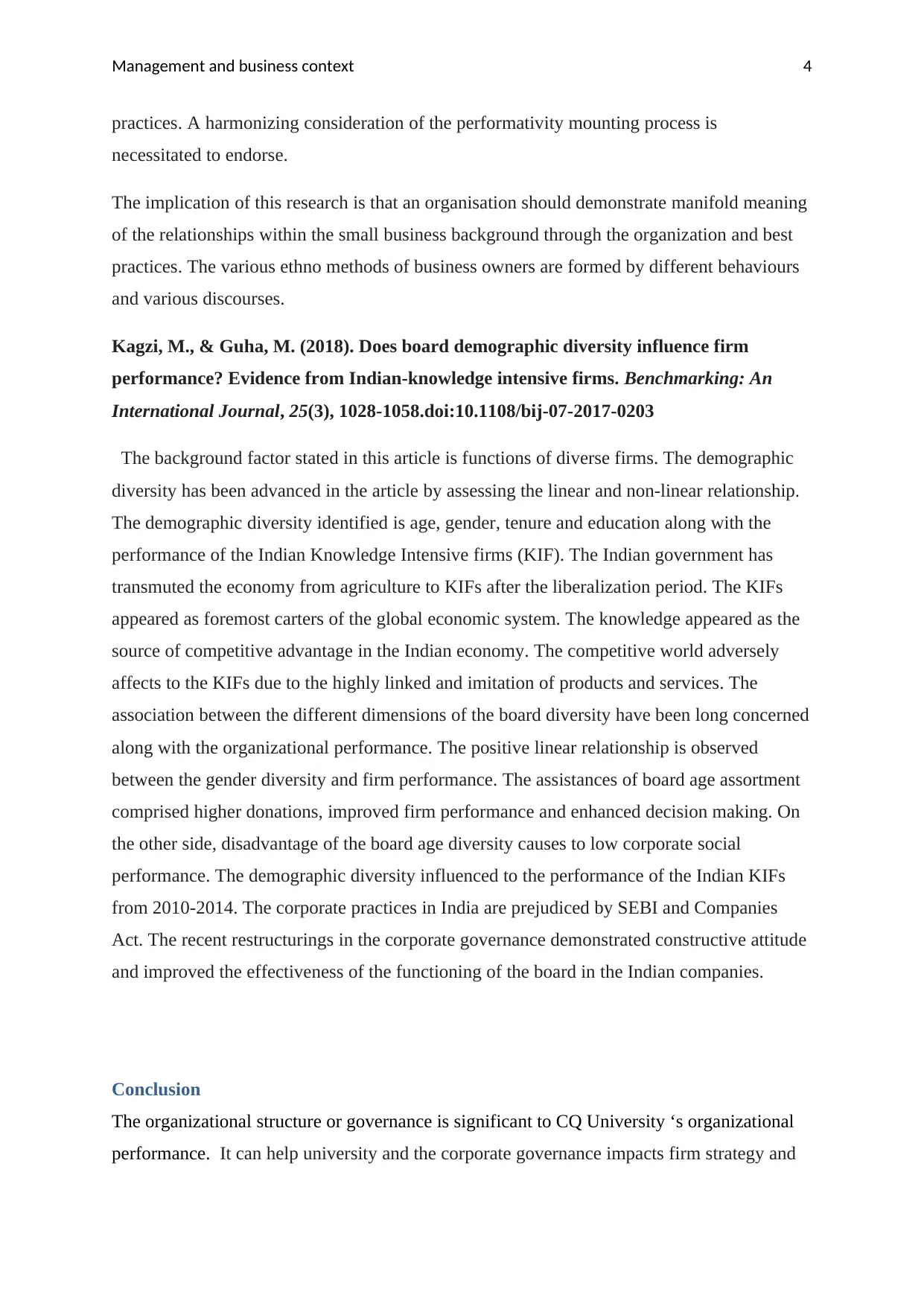
Management and business context 4
practices. A harmonizing consideration of the performativity mounting process is
necessitated to endorse.
The implication of this research is that an organisation should demonstrate manifold meaning
of the relationships within the small business background through the organization and best
practices. The various ethno methods of business owners are formed by different behaviours
and various discourses.
Kagzi, M., & Guha, M. (2018). Does board demographic diversity influence firm
performance? Evidence from Indian-knowledge intensive firms. Benchmarking: An
International Journal, 25(3), 1028-1058.doi:10.1108/bij-07-2017-0203
The background factor stated in this article is functions of diverse firms. The demographic
diversity has been advanced in the article by assessing the linear and non-linear relationship.
The demographic diversity identified is age, gender, tenure and education along with the
performance of the Indian Knowledge Intensive firms (KIF). The Indian government has
transmuted the economy from agriculture to KIFs after the liberalization period. The KIFs
appeared as foremost carters of the global economic system. The knowledge appeared as the
source of competitive advantage in the Indian economy. The competitive world adversely
affects to the KIFs due to the highly linked and imitation of products and services. The
association between the different dimensions of the board diversity have been long concerned
along with the organizational performance. The positive linear relationship is observed
between the gender diversity and firm performance. The assistances of board age assortment
comprised higher donations, improved firm performance and enhanced decision making. On
the other side, disadvantage of the board age diversity causes to low corporate social
performance. The demographic diversity influenced to the performance of the Indian KIFs
from 2010-2014. The corporate practices in India are prejudiced by SEBI and Companies
Act. The recent restructurings in the corporate governance demonstrated constructive attitude
and improved the effectiveness of the functioning of the board in the Indian companies.
Conclusion
The organizational structure or governance is significant to CQ University ‘s organizational
performance. It can help university and the corporate governance impacts firm strategy and
practices. A harmonizing consideration of the performativity mounting process is
necessitated to endorse.
The implication of this research is that an organisation should demonstrate manifold meaning
of the relationships within the small business background through the organization and best
practices. The various ethno methods of business owners are formed by different behaviours
and various discourses.
Kagzi, M., & Guha, M. (2018). Does board demographic diversity influence firm
performance? Evidence from Indian-knowledge intensive firms. Benchmarking: An
International Journal, 25(3), 1028-1058.doi:10.1108/bij-07-2017-0203
The background factor stated in this article is functions of diverse firms. The demographic
diversity has been advanced in the article by assessing the linear and non-linear relationship.
The demographic diversity identified is age, gender, tenure and education along with the
performance of the Indian Knowledge Intensive firms (KIF). The Indian government has
transmuted the economy from agriculture to KIFs after the liberalization period. The KIFs
appeared as foremost carters of the global economic system. The knowledge appeared as the
source of competitive advantage in the Indian economy. The competitive world adversely
affects to the KIFs due to the highly linked and imitation of products and services. The
association between the different dimensions of the board diversity have been long concerned
along with the organizational performance. The positive linear relationship is observed
between the gender diversity and firm performance. The assistances of board age assortment
comprised higher donations, improved firm performance and enhanced decision making. On
the other side, disadvantage of the board age diversity causes to low corporate social
performance. The demographic diversity influenced to the performance of the Indian KIFs
from 2010-2014. The corporate practices in India are prejudiced by SEBI and Companies
Act. The recent restructurings in the corporate governance demonstrated constructive attitude
and improved the effectiveness of the functioning of the board in the Indian companies.
Conclusion
The organizational structure or governance is significant to CQ University ‘s organizational
performance. It can help university and the corporate governance impacts firm strategy and
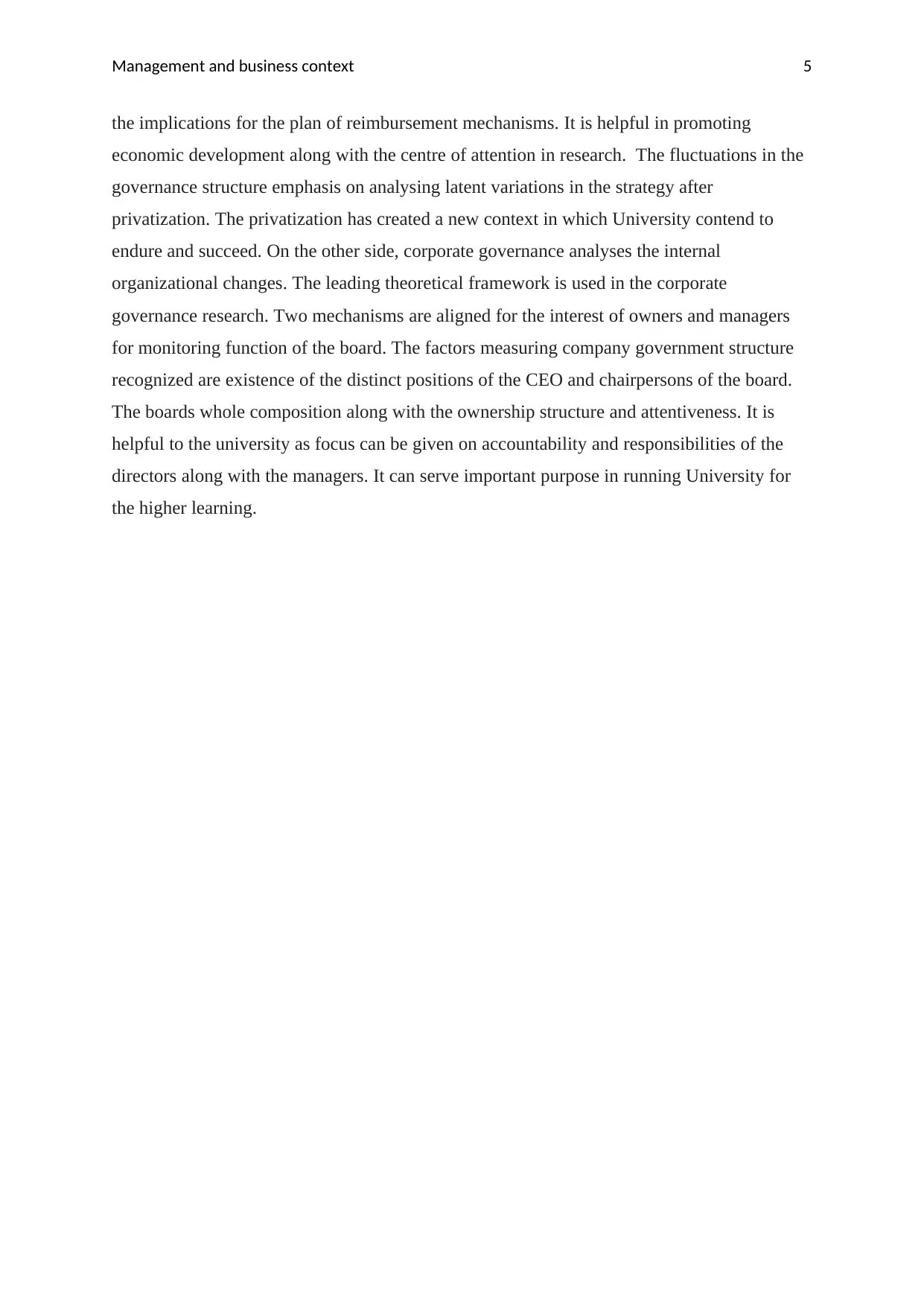
Management and business context 5
the implications for the plan of reimbursement mechanisms. It is helpful in promoting
economic development along with the centre of attention in research. The fluctuations in the
governance structure emphasis on analysing latent variations in the strategy after
privatization. The privatization has created a new context in which University contend to
endure and succeed. On the other side, corporate governance analyses the internal
organizational changes. The leading theoretical framework is used in the corporate
governance research. Two mechanisms are aligned for the interest of owners and managers
for monitoring function of the board. The factors measuring company government structure
recognized are existence of the distinct positions of the CEO and chairpersons of the board.
The boards whole composition along with the ownership structure and attentiveness. It is
helpful to the university as focus can be given on accountability and responsibilities of the
directors along with the managers. It can serve important purpose in running University for
the higher learning.
the implications for the plan of reimbursement mechanisms. It is helpful in promoting
economic development along with the centre of attention in research. The fluctuations in the
governance structure emphasis on analysing latent variations in the strategy after
privatization. The privatization has created a new context in which University contend to
endure and succeed. On the other side, corporate governance analyses the internal
organizational changes. The leading theoretical framework is used in the corporate
governance research. Two mechanisms are aligned for the interest of owners and managers
for monitoring function of the board. The factors measuring company government structure
recognized are existence of the distinct positions of the CEO and chairpersons of the board.
The boards whole composition along with the ownership structure and attentiveness. It is
helpful to the university as focus can be given on accountability and responsibilities of the
directors along with the managers. It can serve important purpose in running University for
the higher learning.
⊘ This is a preview!⊘
Do you want full access?
Subscribe today to unlock all pages.

Trusted by 1+ million students worldwide
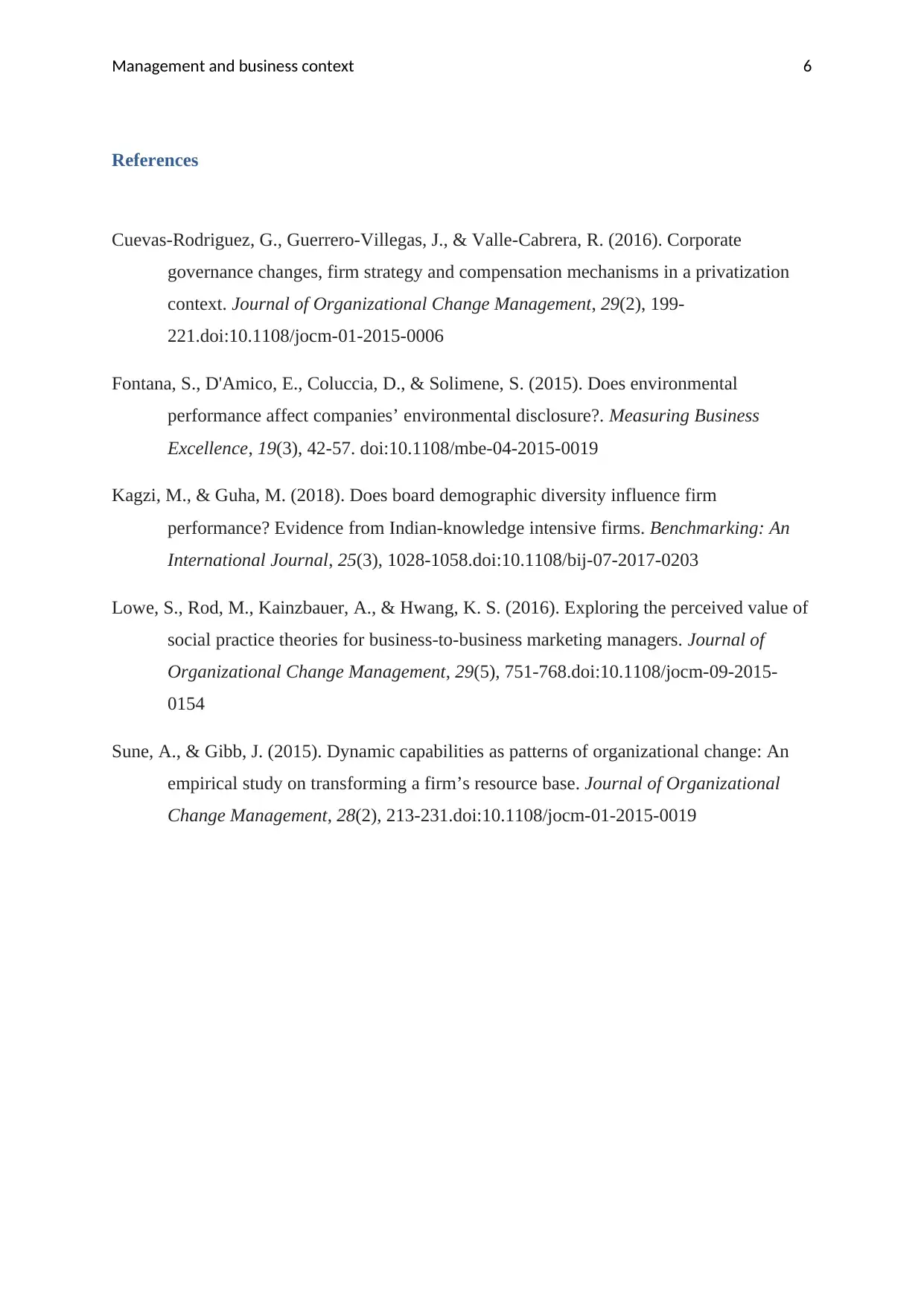
Management and business context 6
References
Cuevas-Rodriguez, G., Guerrero-Villegas, J., & Valle-Cabrera, R. (2016). Corporate
governance changes, firm strategy and compensation mechanisms in a privatization
context. Journal of Organizational Change Management, 29(2), 199-
221.doi:10.1108/jocm-01-2015-0006
Fontana, S., D'Amico, E., Coluccia, D., & Solimene, S. (2015). Does environmental
performance affect companies’ environmental disclosure?. Measuring Business
Excellence, 19(3), 42-57. doi:10.1108/mbe-04-2015-0019
Kagzi, M., & Guha, M. (2018). Does board demographic diversity influence firm
performance? Evidence from Indian-knowledge intensive firms. Benchmarking: An
International Journal, 25(3), 1028-1058.doi:10.1108/bij-07-2017-0203
Lowe, S., Rod, M., Kainzbauer, A., & Hwang, K. S. (2016). Exploring the perceived value of
social practice theories for business-to-business marketing managers. Journal of
Organizational Change Management, 29(5), 751-768.doi:10.1108/jocm-09-2015-
0154
Sune, A., & Gibb, J. (2015). Dynamic capabilities as patterns of organizational change: An
empirical study on transforming a firm’s resource base. Journal of Organizational
Change Management, 28(2), 213-231.doi:10.1108/jocm-01-2015-0019
References
Cuevas-Rodriguez, G., Guerrero-Villegas, J., & Valle-Cabrera, R. (2016). Corporate
governance changes, firm strategy and compensation mechanisms in a privatization
context. Journal of Organizational Change Management, 29(2), 199-
221.doi:10.1108/jocm-01-2015-0006
Fontana, S., D'Amico, E., Coluccia, D., & Solimene, S. (2015). Does environmental
performance affect companies’ environmental disclosure?. Measuring Business
Excellence, 19(3), 42-57. doi:10.1108/mbe-04-2015-0019
Kagzi, M., & Guha, M. (2018). Does board demographic diversity influence firm
performance? Evidence from Indian-knowledge intensive firms. Benchmarking: An
International Journal, 25(3), 1028-1058.doi:10.1108/bij-07-2017-0203
Lowe, S., Rod, M., Kainzbauer, A., & Hwang, K. S. (2016). Exploring the perceived value of
social practice theories for business-to-business marketing managers. Journal of
Organizational Change Management, 29(5), 751-768.doi:10.1108/jocm-09-2015-
0154
Sune, A., & Gibb, J. (2015). Dynamic capabilities as patterns of organizational change: An
empirical study on transforming a firm’s resource base. Journal of Organizational
Change Management, 28(2), 213-231.doi:10.1108/jocm-01-2015-0019
1 out of 7
Related Documents
Your All-in-One AI-Powered Toolkit for Academic Success.
+13062052269
info@desklib.com
Available 24*7 on WhatsApp / Email
![[object Object]](/_next/static/media/star-bottom.7253800d.svg)
Unlock your academic potential
Copyright © 2020–2025 A2Z Services. All Rights Reserved. Developed and managed by ZUCOL.


